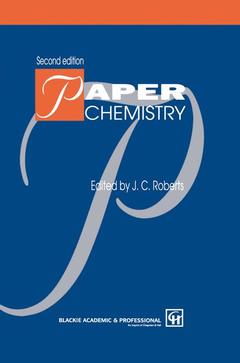Description
Paper Chemistry (2nd Ed., 2nd ed. 1996)
Author: Roberts J.C.
Language: English
Subjects for Paper Chemistry:
Keywords
additive; additives; chemistry; electrolyte; kinetics; polyelectrolyte; polymer
Approximative price 210.99 €
In Print (Delivery period: 15 days).
Add to cart
Publication date: 09-2012
267 p. · 15.5x23.5 cm · Paperback
267 p. · 15.5x23.5 cm · Paperback
Description
/li>Contents
/li>Comment
/li>
Although the title of this book is Paper Chemistry, it should be considered as a text about the chemistry of the formation of paper from aqueous suspensions of fibre and other additives, rather than as a book about the chemistry of the raw material itself. It is the subject of what papermakers call wet-end chemistry. There are many other excellent texts on the chemistry of cellulose and apart from one chapter on the accessibility of cellulose, the subject is not addressed here. Neither does the book deal with the chemistry of pulp preparation (from wood, from other plant sources or from recycled fibres), for there are also many excellent texts on this subject. The first edition of this book was a great success and soon became established as one of the Bibles of the industry. Its achievement then was to collect the considerable advances in understanding which had been made in the chemistry of papermaking in previous years, and provide, for the first time, a sound physico chemical basis of the subject. This new edition has been thoroughly updated with much new material added. The formation of paper is a continuous filtration process in which cellulosic fibres are formed into a network which is then pressed and dried. The important chemistry involved in this process is firstly the retention of col loidal material during filtration and secondly the modification of fibre and sheet properties so as to widen the scope for the use of paper and board products.
Applications of paper chemistry. Accessibility of cellulose. Electrokinetics of the papermaking industry. Mechanisms of flocculation and stabilisation of suspensions by organic polymers. Retention aids. Dry-strength additives. Wet-strength chemistry. The sizing of paper with rosin and alum at acid pHs. Neutral and alkaline sizing. Dyes and fluorescent whitening agents for paper. Physical and chemical aspects of the use of fillers in paper. Measurement and control. Practical applications of paper chemistry. Index.
This new edition has been thoroughly updated, and includes substantial amounts of new material. The book continues to cover the chemistry of papermaking to the mill and provides a sound physico-chemical background to the subject which has been recognizes as uniquely valuable. Changes to the new edition include new chapters on polyelectrolytes , the chemistry of recycling and deinking. Well indexed, and with extensive reference to primary and research literature, it provides an unparalleled entry to the subject.
© 2024 LAVOISIER S.A.S.

